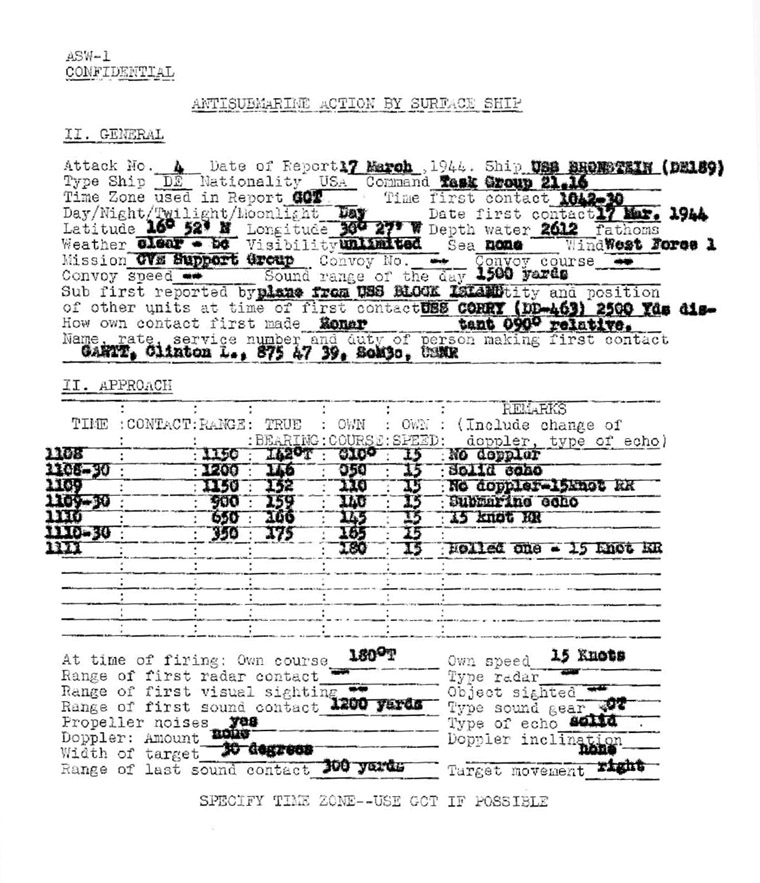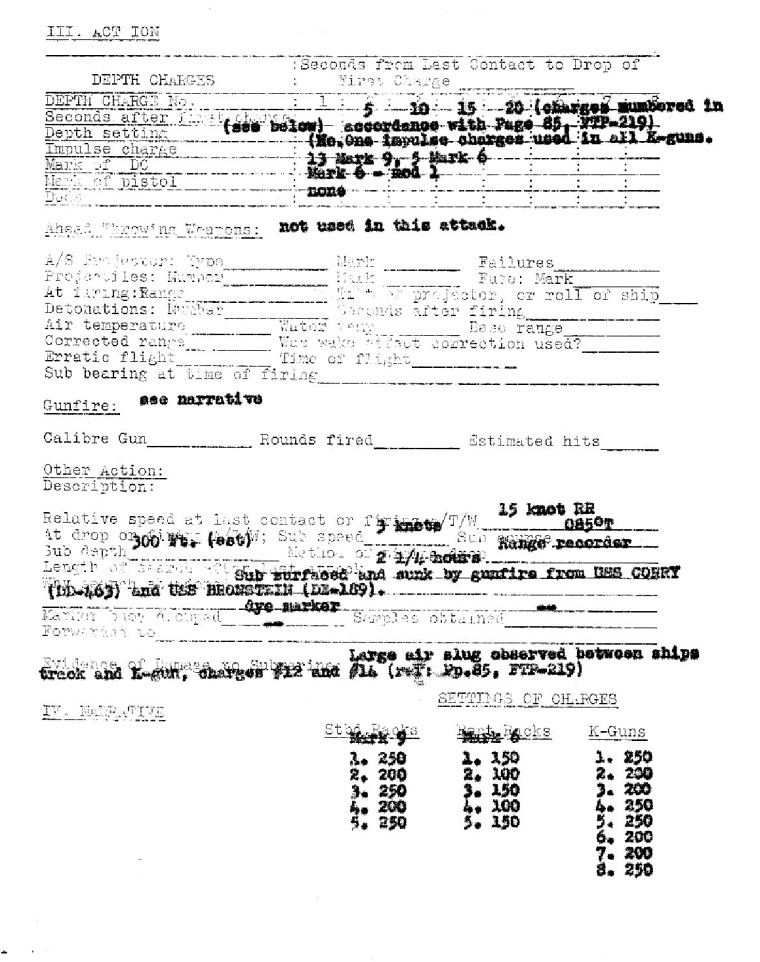|
|||||||||||||||||||||||||||||||||||
| Serial No. 0090 18 March 1944. | |||||||||||||||||||||||||||||||||||
| S-E-C-R-E-T | |||||||||||||||||||||||||||||||||||
|
|||||||||||||||||||||||||||||||||||
| 1. In accordance with references (a) and (b), enclosure (A) is forwarded herewith. | |||||||||||||||||||||||||||||||||||
| S.H.KINNEY | |||||||||||||||||||||||||||||||||||
| Advance copy to: | |||||||||||||||||||||||||||||||||||
| CominCh (accompanied by sound | |||||||||||||||||||||||||||||||||||
| recorder trace, fathometer | |||||||||||||||||||||||||||||||||||
| trace and track chart) | |||||||||||||||||||||||||||||||||||
| ASDevLant | |||||||||||||||||||||||||||||||||||
| LantASW Unit | |||||||||||||||||||||||||||||||||||
| Transmission of this document by registered mail within the continental limits of the United States is authorized. | |||||||||||||||||||||||||||||||||||
U. S. S. BRONSTEIN (DE-189) |
||
| S-E-C-R-E-T ACTION REPORT | ||
Sinking of German U-boat on 17 March 1944 |
||
| Part I. | ||
| A. Composition of Own Forces. | ||
| Commander Task Group 21.16, Captain Francis M. HUGES, U.S. Navy, in BLOCK ISLAND; Commander Inner Screen, Commander Escort Division 48, Commander G.W. PARKINSON, U.S.N.R., in THOMAS. Task Group 21.16, U.S.S. BLOCK ISLAND (CVE-21), U.S.S. CORRY (DD-463), U.S.S. THOMAS (DE-102), U.S.S. BOSTWICK (DE-103), U.S.S. BREEMAN (DE-104), and U.S.S. BRONSTEIN (DE-189). | ||
| B. Preliminary Operations. | ||
| This Task Group departed Casablanca on 11 March 1944 to operate against a German submarine refueling concentration northwest of the Cape Verde Islands. On the morning of 17 March 1944 the group was operating in vicinity of Latitude 17 N. and Longitude 30 W. | ||
| C. Mission. | ||
| To seek out and destroy enemy submarines. | ||
| D. Doctrine. | ||
| Destroyer Escorts furnish sound screen to escort carrier for her protection, and employ anti-submarine tactics when detached by Task Group Commander from screen to attack enemy submarines. USF-10A governed all screening operations. FTP-219 governed all ASW operations. | ||
| E. Tactical Aspects. | ||
| 1. At 1840 GCT on March 16, 1944, Task Group Commander directed CORRY to proceed to a position where aircraft had reported submarine sighting. This position lay (as far as this vessel could gather) 208°T distant about 23 miles. The remainder of the escorts and BLOCK ISLAND proceeded on this course at 17 knots following CORRY. | ||
| 2. Frequent counter marches were necessary in order to recover or launch aircraft, and little progress was made in the direction of the contact. Flying operations were conducted throughout the night, the destroyer escorts screening and plane guarding BLOCK ISLAND. It was later learned that aircraft had killed two men of the enemy submarine and put his periscope out of commission. By the time CORRY reached the position the submarine had submerged and CORRY searched throughout the night in that vicinity. | ||
- 1 - |
||
| Page Two (2) - - USS BRONSTEIN (DE-189) ACTION REPORT of 17 March 1944. | ||||||||||||||||||||||||||||||||||||||||||||||||
| S-E-C-R-E-T | ||||||||||||||||||||||||||||||||||||||||||||||||
| 3. At 0717 March 17, 1944 CTG 21.16 ordered BRONSTEIN to proceed and assist CORRY in the search for the submarine. | ||||||||||||||||||||||||||||||||||||||||||||||||
| Part II. Narrative of Action. | ||||||||||||||||||||||||||||||||||||||||||||||||
|
||||||||||||||||||||||||||||||||||||||||||||||||
- 2 - |
||||||||||||||||||||||||||||||||||||||||||||||||
| Page Three (3) - - USS BRONSTEIN (DE-189) ACTION REPORT of 17 March 1944. | ||||||||||||||||||||||||||||||||||||||||
| S-E-C-R-E-T | ||||||||||||||||||||||||||||||||||||||||
|
||||||||||||||||||||||||||||||||||||||||
- 3 - |
||||||||||||||||||||||||||||||||||||||||
| Page Four (4) - - USS BRONSTEIN (DE-189) ACTION REPORT of 17 March 1944. | ||||||||||||||||||||||||||||||||||||||||||||
| S-E-C-R-E-T | ||||||||||||||||||||||||||||||||||||||||||||
|
||||||||||||||||||||||||||||||||||||||||||||
- 4 - |
||||||||||||||||||||||||||||||||||||||||||||
| Page Five (5) - - USS BRONSTEIN (DE-189) ACTION REPORT of 17 March 1944. | ||||||||||||||||||||||||||||||||
| S-E-C-R-E-T | ||||||||||||||||||||||||||||||||
|
||||||||||||||||||||||||||||||||
- 5 - |
||||||||||||||||||||||||||||||||
| Page Six (6) - - USS BRONSTEIN (DE-189) ACTION REPORT of 17 March 1944. | ||||||||||||||||||||||||||||||||||||||
| S-E-C-R-E-T | ||||||||||||||||||||||||||||||||||||||
|
||||||||||||||||||||||||||||||||||||||
- 6 - |
||||||||||||||||||||||||||||||||||||||
| Page Two (2) - - USS BRONSTEIN (DE-189) ACTION REPORT of 17 March 1944. | ||||||||||||
| S-E-C-R-E-T | ||||||||||||
|
||||||||||||
| Part II Commanding Officer's Comments | ||||||||||||
| 1. The entire task group contributed to the sinking of this submarine. THe result was the product of teamwork that realized fully the mission of CVE groups by combining every weapon, air and surface. | ||||||||||||
| 2. The Commanding Officer of U.S.S. CORRY deserves great credit for the manner in which he employed that ship and U.S.S. BRONSTEIN to persistently attack the submarine over a period of hours until it was forced to surface. Although contact was lost several times Lieutenant Commander C.D. HOFFMAN, U.S. Navy so conducted the search that each time contact with the submarine was regained and the attacks continued. | ||||||||||||
| 3. Although the surface ships finished the submarine, this would have been impossible had not aircraft commenced the action, and the following day directed the surface vessels to the submarine's position. | ||||||||||||
| 4. The Destroyer Escort as a class is frequently criticized for its lack of offensive power. Unfortunately the major portion of this criticism comes from the very officers who man these vessels. This commanding officer has nothing but praise for the armament of these ships. In this and a previous engagement the battery gave an excellent account of itself. For this type of duty these ships are engaged in it is sufficient. The fire of these vessels can be accurate, rapid and heavy. It is regretted that in each case where this ship encountered an enemy on the surface, torpedo fire was impossible due to danger to ships of own task group. | ||||||||||||
| 5. It should be noted that the BRONSTEIN was on her first duty following her shakedown period which ended 7 February 1944 on which date she reported for duty. Credit is reflected | ||||||||||||
- 7 - |
||||||||||||
| Page Eight (8) - - USS BRONSTEIN (DE-189) ACTION REPORT of 17 March 1944. | ||
| S-E-C-R-E-T | ||
| upon the DEstroyer Escort Shakedown Group, Bermuda, which prepared this ship to take her place in the fleet, ready to fight, in a very short period. | ||
| S.H.KINNEY_________ | ||
| Lieutenant, U.S. Navy, | ||
| Commanding Officer. | ||


